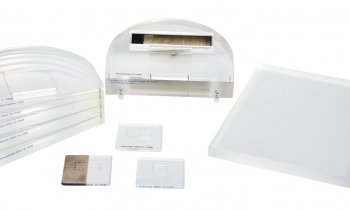Large capacity intensive care ambulances
By Dr Martin von Bergh
In March 2008 over 200 cars were involved in a mass traffic accident caused by fog between Abu Dhabi and Dubai. Six passengers were killed; hundreds were injured. Similar road traffic accidents, airplane crashes on the most frequented hub in the region and fires in factories and skyscrapers are among the mass casualty events that the Dubai Centre of Ambulance Services face on a daily basis.


To optimise the use of available rescue personnel and improve the effectiveness of response to large scale disasters, the Dubai Government ordered three high-tech Large Capacity Intensive Care Ambulances from Germany.
My company, Von Bergh Global Medical Consulting, which specialises in emergency and disaster management consulting, was assigned by the Dubai Government to design and develop a new type of ambulance that can treat and transport high numbers of injured patients at the highest possible medical level. Under our medical supervision, Gebr. Heymann GmbH, which specialises in emergency vehicle construction, converted two Mercedes Citaro and one Mercedes Citaro G buses into three mobile clinics with operating theatres, intensive care and intermediate care units. These exceeded the diagnostic and treatment possibilities of anything currently existing worldwide, said Dr von Bergh.
The Heymann company had already produced similar vehicles on a lower technological level for the state of Rhineland-Palatinate; these were utilised during the Soccer World Championship in 2006. Cytomed Middle East, the medical technology retailer and local partner in the consortium, elevated the existing level of mass casualty ambulance buses to an advanced hospital standard by supplying a mobile X-ray device, ultrasound and advanced intensive care monitoring such as the InSpectra tissue oxygenation monitor.
The medical technology level not only exceeds existing standards but so does the size of one of the buses, which broke the existing Guinness World Record in September 2009 for the Largest Ambulance with its 20.03 metres length and a total patient treatment and transport capacity of 123 people, all on board at the same time.
The operating theatre, which was assembled in two of the three buses, offers the possibility for a wide spectrum of emergency surgical interventions. This is possible through the installation of a fully functional operating table, OR-light, surgical washbasin and pre-packed sets of disposable surgical equipment, including gowns, gloves, sutures and all surgical instruments needed for small and large emergency interventions, thorax drainage, central intravenous line and Caesarean section.
The Intensive Care Units (ICU) are equipped with ECG/defibrillators with BP, HR, SpO2 and C O2 monitoring, portable ventilation devices, infusion pumps and suction units. The one device that lifts the monitoring options above the ambulance level and onto the level of hospital ICU is the ‘shock monitor’ -- the InSpectra StO2 tissue oxygenation monitor from Hutchinson Technologies. This makes it possible to measure the patients’ oxygen level in the deep muscle tissue continuously and non-invasively on the thumb. What makes the measured StO2 so valuable is the correlation of this new parameter with the central oxygen level (SvO2), so that it can be seen in advance if a patient is going into shock, or is bleeding internally or destabilising in any other haemodynamic way.
The Intermediate Care Units offer basic monitoring of heart rate and SpO2 for patients lying down when transported. In addition each bus offers additional mass transport capacities for slightly injured patients or disaster bystanders.
Another novelty that was installed in each one of these Field Support Units is the computer controlled and central oxygen supply system supplied by Heyer Aerotech. This was the first installation in a mobile medical facility and makes it possible to supply 12,000 litres of medical oxygen stored in bottles to every area in the bus for every patient on board.
Should medical support be needed at a disaster site for an extended period of time, it is possible to arrange the three buses ordered by the Dubai Centre of Ambulance Services into a certain formation that enables entrances to be connected via inflatable tents. In effect, this creates a fully operational field hospital within seconds.
So far, the pre-hospital emergency response by ambulances was the sole responsibility of Dubai paramedics. With the new concept of mass casualty ambulances, Von Bergh Global Medical Consulting, which has been involved in the training of disaster responders in Dubai for the last few years, brings elements of the German physician-based Emergency Medical Services (EMS) to this part of the world.
Similar to Germany, Dubai will bring emergency physicians from the hospital setting to the disaster site to perform critical interventions and patient stabilisation in the buses – in the field -- and afterwards transport the stable patient to the treatment facility.
This increased level of on-site medical treatment quality will make effective use of available human resources and reduce time for disaster victims to receive life-saving medical care. The increasing complexity of mass casualty incidents can be responded to in the most effective way by using state-of-the-art medical concepts such as the Large Capacity Intensive Care Ambulances. The new operational concept associated with this new form of disaster response vehicle may result in an overall improvement of the emergency medical response that could lead to a higher survival rate and reduction of morbidity of disaster victims.
Dr. Martin von Bergh can be contacted at MEDICA. Phone: +49 177 5206003
19.11.2009











